Market Analysis of Tesco with Market Structure
VerifiedAdded on 2023/01/07
|13
|3353
|70
AI Summary
This report provides an overview of Tesco, its products/services, history, and market structure. It discusses the characteristics of previous and current market structure and suggests optimal structure for Tesco. It also explores the role of government interventions in the business entity.
Contribute Materials
Your contribution can guide someone’s learning journey. Share your
documents today.
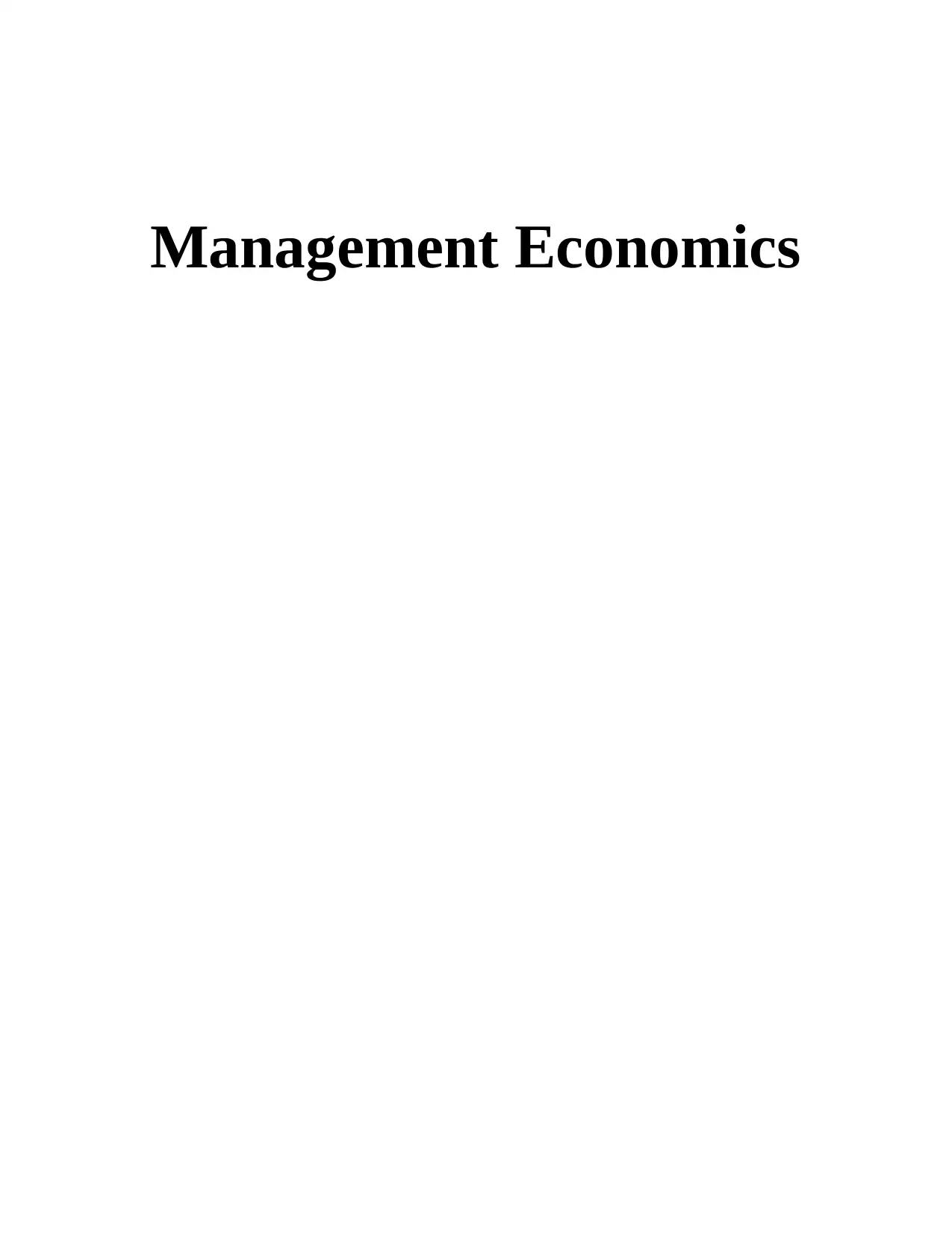
Management Economics
Secure Best Marks with AI Grader
Need help grading? Try our AI Grader for instant feedback on your assignments.

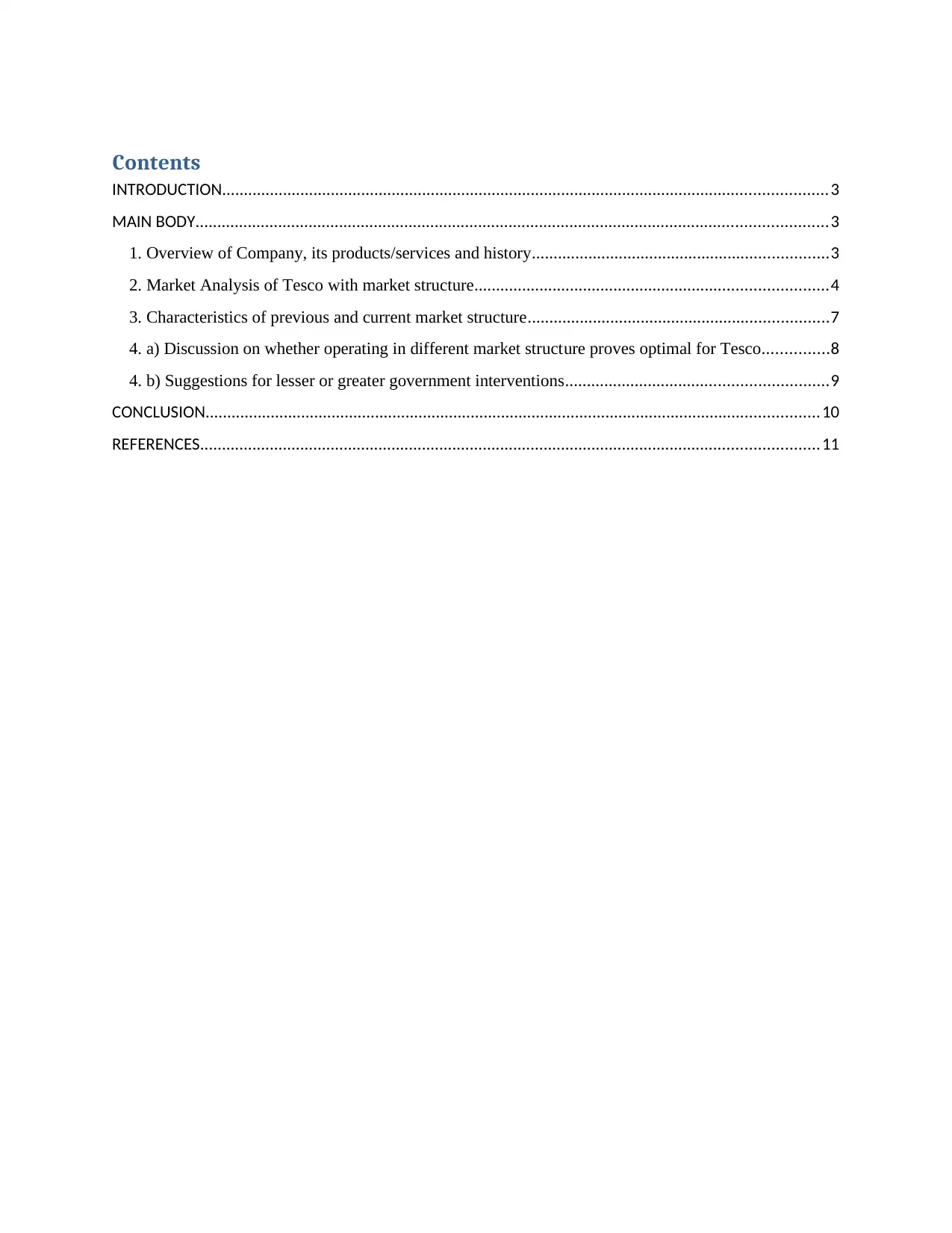
Contents
INTRODUCTION...........................................................................................................................................3
MAIN BODY.................................................................................................................................................3
1. Overview of Company, its products/services and history....................................................................3
2. Market Analysis of Tesco with market structure.................................................................................4
3. Characteristics of previous and current market structure.....................................................................7
4. a) Discussion on whether operating in different market structure proves optimal for Tesco...............8
4. b) Suggestions for lesser or greater government interventions............................................................9
CONCLUSION.............................................................................................................................................10
REFERENCES..............................................................................................................................................11
INTRODUCTION...........................................................................................................................................3
MAIN BODY.................................................................................................................................................3
1. Overview of Company, its products/services and history....................................................................3
2. Market Analysis of Tesco with market structure.................................................................................4
3. Characteristics of previous and current market structure.....................................................................7
4. a) Discussion on whether operating in different market structure proves optimal for Tesco...............8
4. b) Suggestions for lesser or greater government interventions............................................................9
CONCLUSION.............................................................................................................................................10
REFERENCES..............................................................................................................................................11
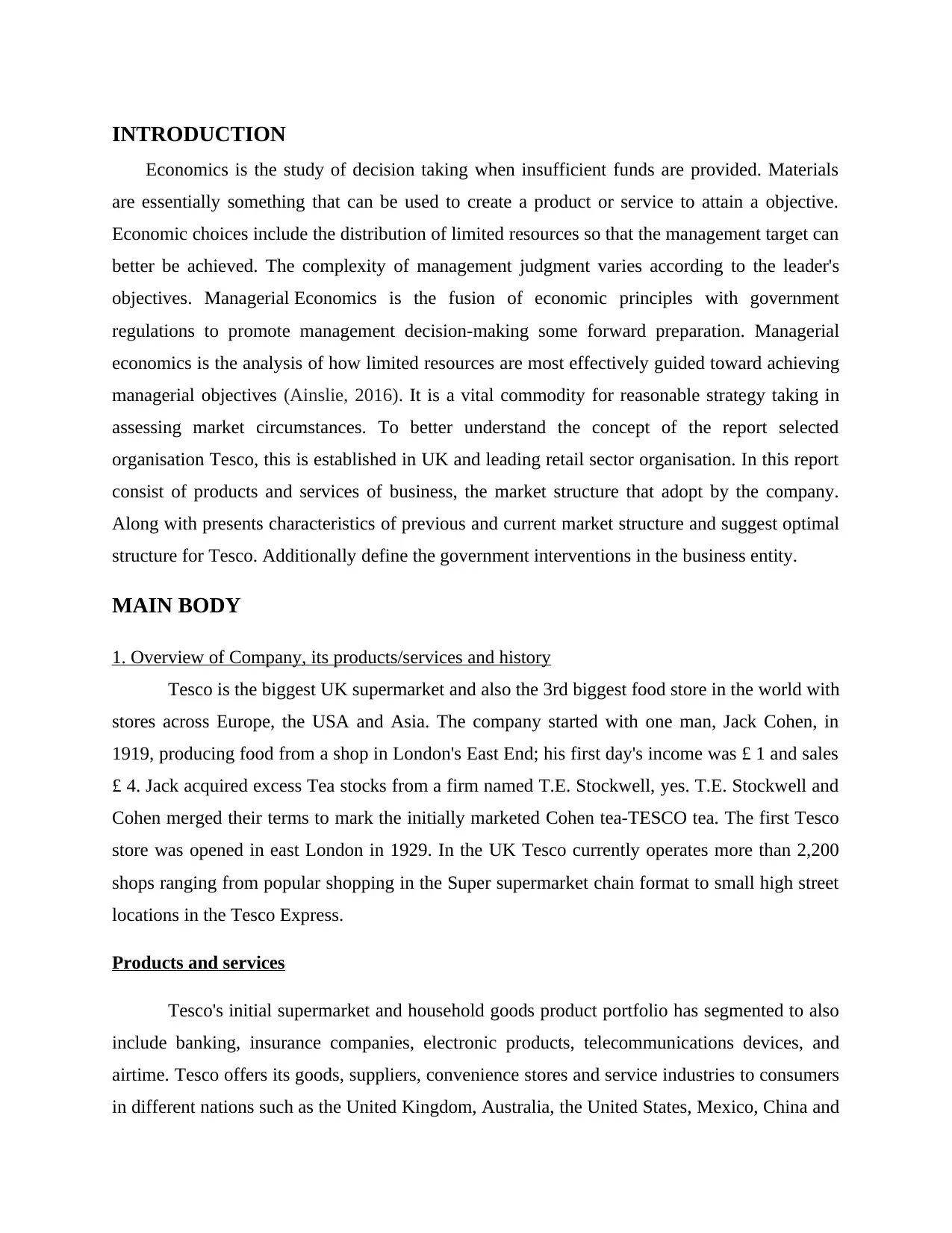
INTRODUCTION
Economics is the study of decision taking when insufficient funds are provided. Materials
are essentially something that can be used to create a product or service to attain a objective.
Economic choices include the distribution of limited resources so that the management target can
better be achieved. The complexity of management judgment varies according to the leader's
objectives. Managerial Economics is the fusion of economic principles with government
regulations to promote management decision-making some forward preparation. Managerial
economics is the analysis of how limited resources are most effectively guided toward achieving
managerial objectives (Ainslie, 2016). It is a vital commodity for reasonable strategy taking in
assessing market circumstances. To better understand the concept of the report selected
organisation Tesco, this is established in UK and leading retail sector organisation. In this report
consist of products and services of business, the market structure that adopt by the company.
Along with presents characteristics of previous and current market structure and suggest optimal
structure for Tesco. Additionally define the government interventions in the business entity.
MAIN BODY
1. Overview of Company, its products/services and history
Tesco is the biggest UK supermarket and also the 3rd biggest food store in the world with
stores across Europe, the USA and Asia. The company started with one man, Jack Cohen, in
1919, producing food from a shop in London's East End; his first day's income was £ 1 and sales
£ 4. Jack acquired excess Tea stocks from a firm named T.E. Stockwell, yes. T.E. Stockwell and
Cohen merged their terms to mark the initially marketed Cohen tea-TESCO tea. The first Tesco
store was opened in east London in 1929. In the UK Tesco currently operates more than 2,200
shops ranging from popular shopping in the Super supermarket chain format to small high street
locations in the Tesco Express.
Products and services
Tesco's initial supermarket and household goods product portfolio has segmented to also
include banking, insurance companies, electronic products, telecommunications devices, and
airtime. Tesco offers its goods, suppliers, convenience stores and service industries to consumers
in different nations such as the United Kingdom, Australia, the United States, Mexico, China and
Economics is the study of decision taking when insufficient funds are provided. Materials
are essentially something that can be used to create a product or service to attain a objective.
Economic choices include the distribution of limited resources so that the management target can
better be achieved. The complexity of management judgment varies according to the leader's
objectives. Managerial Economics is the fusion of economic principles with government
regulations to promote management decision-making some forward preparation. Managerial
economics is the analysis of how limited resources are most effectively guided toward achieving
managerial objectives (Ainslie, 2016). It is a vital commodity for reasonable strategy taking in
assessing market circumstances. To better understand the concept of the report selected
organisation Tesco, this is established in UK and leading retail sector organisation. In this report
consist of products and services of business, the market structure that adopt by the company.
Along with presents characteristics of previous and current market structure and suggest optimal
structure for Tesco. Additionally define the government interventions in the business entity.
MAIN BODY
1. Overview of Company, its products/services and history
Tesco is the biggest UK supermarket and also the 3rd biggest food store in the world with
stores across Europe, the USA and Asia. The company started with one man, Jack Cohen, in
1919, producing food from a shop in London's East End; his first day's income was £ 1 and sales
£ 4. Jack acquired excess Tea stocks from a firm named T.E. Stockwell, yes. T.E. Stockwell and
Cohen merged their terms to mark the initially marketed Cohen tea-TESCO tea. The first Tesco
store was opened in east London in 1929. In the UK Tesco currently operates more than 2,200
shops ranging from popular shopping in the Super supermarket chain format to small high street
locations in the Tesco Express.
Products and services
Tesco's initial supermarket and household goods product portfolio has segmented to also
include banking, insurance companies, electronic products, telecommunications devices, and
airtime. Tesco offers its goods, suppliers, convenience stores and service industries to consumers
in different nations such as the United Kingdom, Australia, the United States, Mexico, China and
Secure Best Marks with AI Grader
Need help grading? Try our AI Grader for instant feedback on your assignments.

other countries (Bartak, 2017). Tesco has differentiated into such fields as book shopping,
clothes, electronics, furniture, toys, gas, software, financial services, telecommunications and
high speed internet. Through launching new goods or changing the current product, Tesco wants
to reach a broader variety of customers. Further emphasis should be provided in comparing the
quality to shopping products such as garments together with convenience products. Tesco is one
of the nation's biggest grocery retailers, with about 2,318 supermarkets and a workforce from
over 326,000. It delivers on-line shopping thru the Tesco.com affiliate. The UK is the biggest
market for the group, where it works through four Premium, supermarket, Metro and Express
brands. The company sells about 40,000 foodstuffs, including clothes and other non-food items.
Goods on the corporation's internal label (50 percent of sales) are at three stages, value, common
and highest. Most supermarkets include petrol stations as well as grocery products, being one of
Britain's biggest regional petrol distributors. Tesco Personal Finance also provides other retailing
services.
2. Market Analysis of Tesco with market structure
The most enticing latest headlines about Tesco is its current CEO, Philip Clark, who on 2
March 2011 replaced Sir Terry as the leader of the supermarket giant. Two items of information
regarding Tesco's continued move ahead in Southeast China and Northern California were also
revealed during the similar week, respectively, that may contribute to investors' speculation as to
if the new manager, who was Tesco's manager of the foreign and IT company, would pursue a
more proactive approach for its foreign market (Berke-Berga, Dovladbekova and Abula, 2017).
The prospect of its global expansion is still full of doubt, when seen from the company's value
success. The central UK food retail industry still has market share of 30 per cent, but the pace of
overall sales fell to a historically low level. In the United Kingdom, retailers are the key locations
where consumers purchase food and regular things for use. Some supermarkets' scales are very
broad and they also have complex and diverse range items for consumers, such as food, fruit,
meat, documents, television sets and electronics. Target retailers can be easily checked
throughout the nation, and public administrative of retailers often spread across every region.
Tesco is UK's biggest distributor by global revenue as well as regional profit margins. Tesco's
sales had exceeded ¡3.83 billion by the end of 2006. Tesco is the world's 3rd biggest
supermarket behind only Wal-Mart and Carrefour. Oligopolistic is one way of structuring the
market.
clothes, electronics, furniture, toys, gas, software, financial services, telecommunications and
high speed internet. Through launching new goods or changing the current product, Tesco wants
to reach a broader variety of customers. Further emphasis should be provided in comparing the
quality to shopping products such as garments together with convenience products. Tesco is one
of the nation's biggest grocery retailers, with about 2,318 supermarkets and a workforce from
over 326,000. It delivers on-line shopping thru the Tesco.com affiliate. The UK is the biggest
market for the group, where it works through four Premium, supermarket, Metro and Express
brands. The company sells about 40,000 foodstuffs, including clothes and other non-food items.
Goods on the corporation's internal label (50 percent of sales) are at three stages, value, common
and highest. Most supermarkets include petrol stations as well as grocery products, being one of
Britain's biggest regional petrol distributors. Tesco Personal Finance also provides other retailing
services.
2. Market Analysis of Tesco with market structure
The most enticing latest headlines about Tesco is its current CEO, Philip Clark, who on 2
March 2011 replaced Sir Terry as the leader of the supermarket giant. Two items of information
regarding Tesco's continued move ahead in Southeast China and Northern California were also
revealed during the similar week, respectively, that may contribute to investors' speculation as to
if the new manager, who was Tesco's manager of the foreign and IT company, would pursue a
more proactive approach for its foreign market (Berke-Berga, Dovladbekova and Abula, 2017).
The prospect of its global expansion is still full of doubt, when seen from the company's value
success. The central UK food retail industry still has market share of 30 per cent, but the pace of
overall sales fell to a historically low level. In the United Kingdom, retailers are the key locations
where consumers purchase food and regular things for use. Some supermarkets' scales are very
broad and they also have complex and diverse range items for consumers, such as food, fruit,
meat, documents, television sets and electronics. Target retailers can be easily checked
throughout the nation, and public administrative of retailers often spread across every region.
Tesco is UK's biggest distributor by global revenue as well as regional profit margins. Tesco's
sales had exceeded ¡3.83 billion by the end of 2006. Tesco is the world's 3rd biggest
supermarket behind only Wal-Mart and Carrefour. Oligopolistic is one way of structuring the
market.
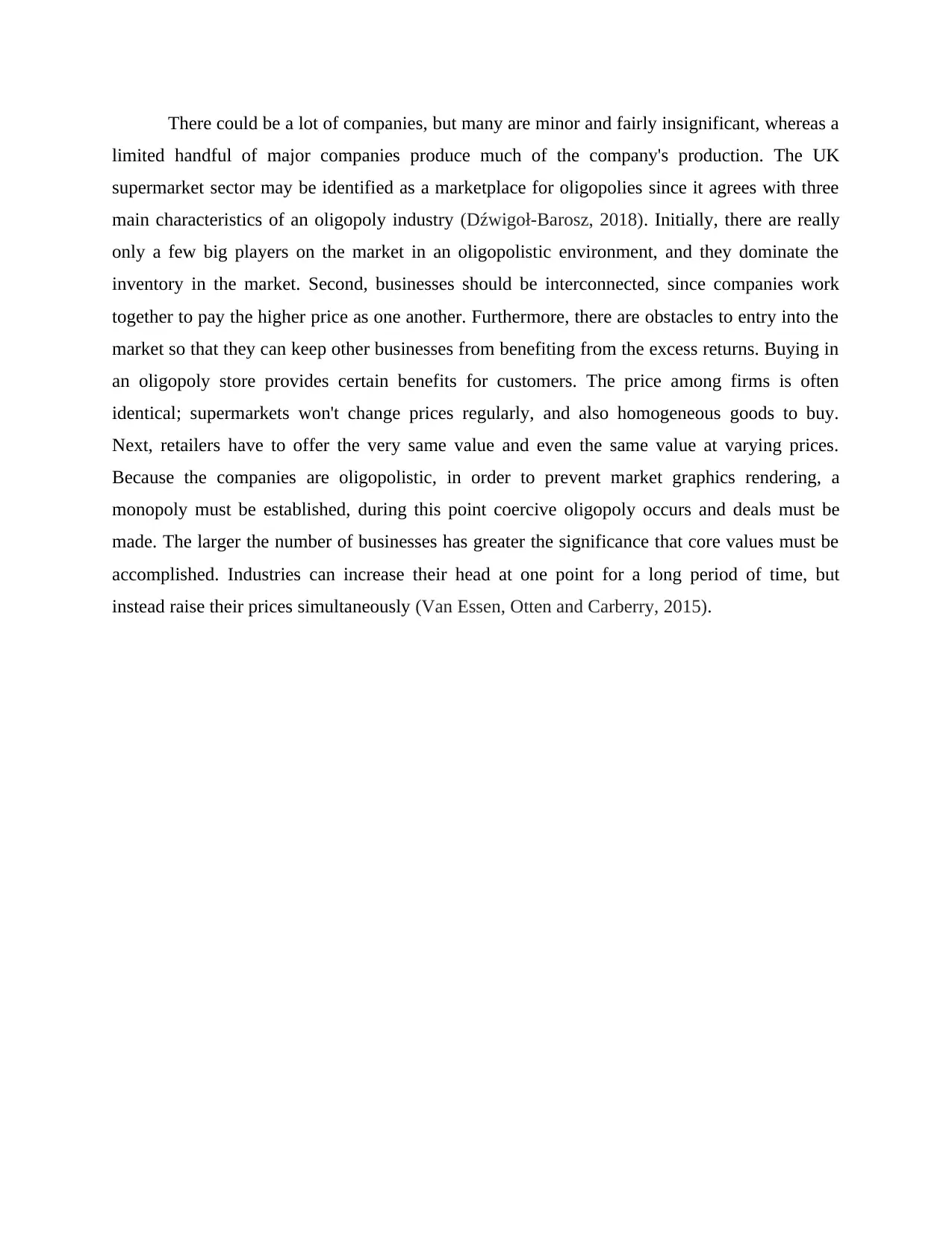
There could be a lot of companies, but many are minor and fairly insignificant, whereas a
limited handful of major companies produce much of the company's production. The UK
supermarket sector may be identified as a marketplace for oligopolies since it agrees with three
main characteristics of an oligopoly industry (Dźwigoł-Barosz, 2018). Initially, there are really
only a few big players on the market in an oligopolistic environment, and they dominate the
inventory in the market. Second, businesses should be interconnected, since companies work
together to pay the higher price as one another. Furthermore, there are obstacles to entry into the
market so that they can keep other businesses from benefiting from the excess returns. Buying in
an oligopoly store provides certain benefits for customers. The price among firms is often
identical; supermarkets won't change prices regularly, and also homogeneous goods to buy.
Next, retailers have to offer the very same value and even the same value at varying prices.
Because the companies are oligopolistic, in order to prevent market graphics rendering, a
monopoly must be established, during this point coercive oligopoly occurs and deals must be
made. The larger the number of businesses has greater the significance that core values must be
accomplished. Industries can increase their head at one point for a long period of time, but
instead raise their prices simultaneously (Van Essen, Otten and Carberry, 2015).
limited handful of major companies produce much of the company's production. The UK
supermarket sector may be identified as a marketplace for oligopolies since it agrees with three
main characteristics of an oligopoly industry (Dźwigoł-Barosz, 2018). Initially, there are really
only a few big players on the market in an oligopolistic environment, and they dominate the
inventory in the market. Second, businesses should be interconnected, since companies work
together to pay the higher price as one another. Furthermore, there are obstacles to entry into the
market so that they can keep other businesses from benefiting from the excess returns. Buying in
an oligopoly store provides certain benefits for customers. The price among firms is often
identical; supermarkets won't change prices regularly, and also homogeneous goods to buy.
Next, retailers have to offer the very same value and even the same value at varying prices.
Because the companies are oligopolistic, in order to prevent market graphics rendering, a
monopoly must be established, during this point coercive oligopoly occurs and deals must be
made. The larger the number of businesses has greater the significance that core values must be
accomplished. Industries can increase their head at one point for a long period of time, but
instead raise their prices simultaneously (Van Essen, Otten and Carberry, 2015).
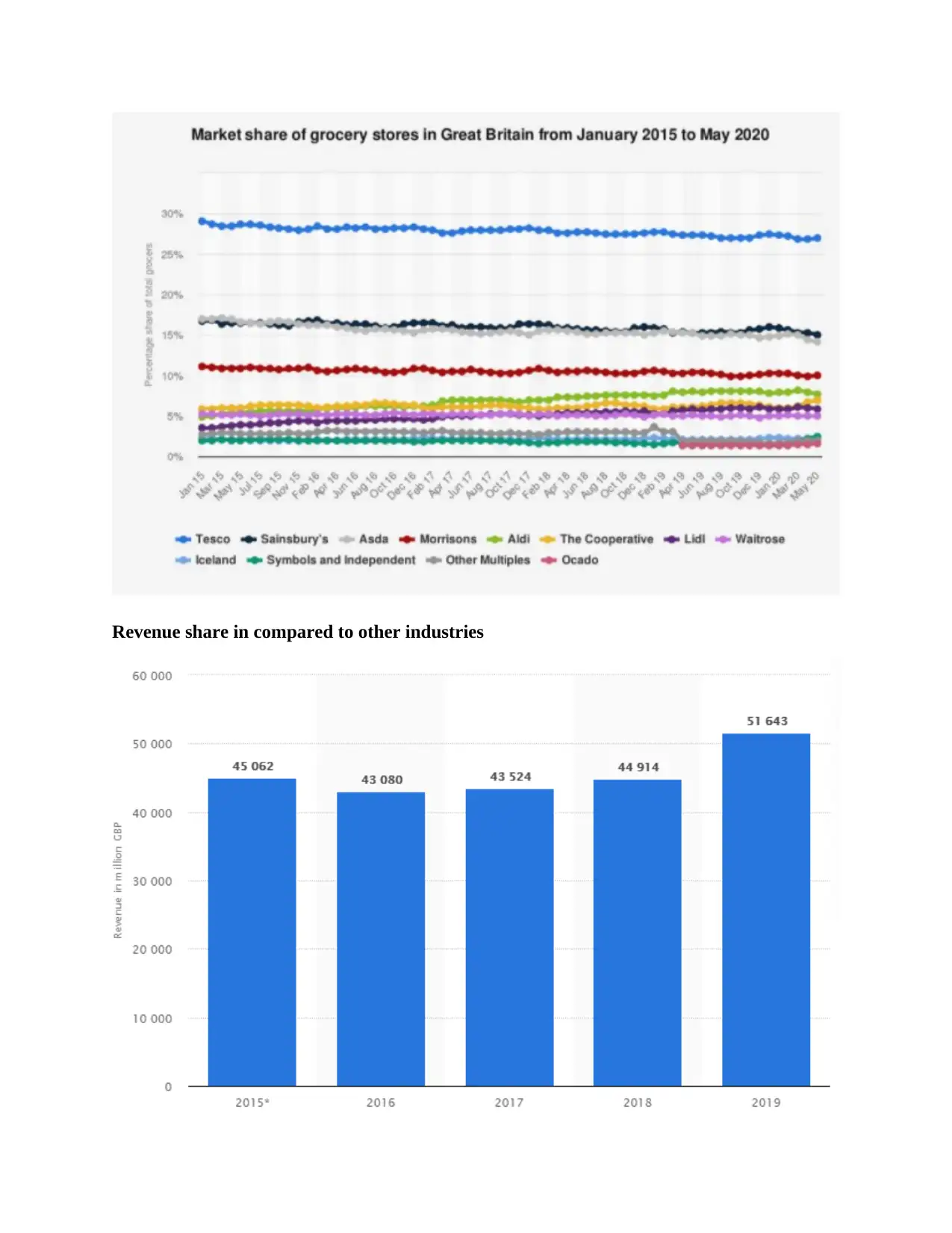
Revenue share in compared to other industries
Paraphrase This Document
Need a fresh take? Get an instant paraphrase of this document with our AI Paraphraser
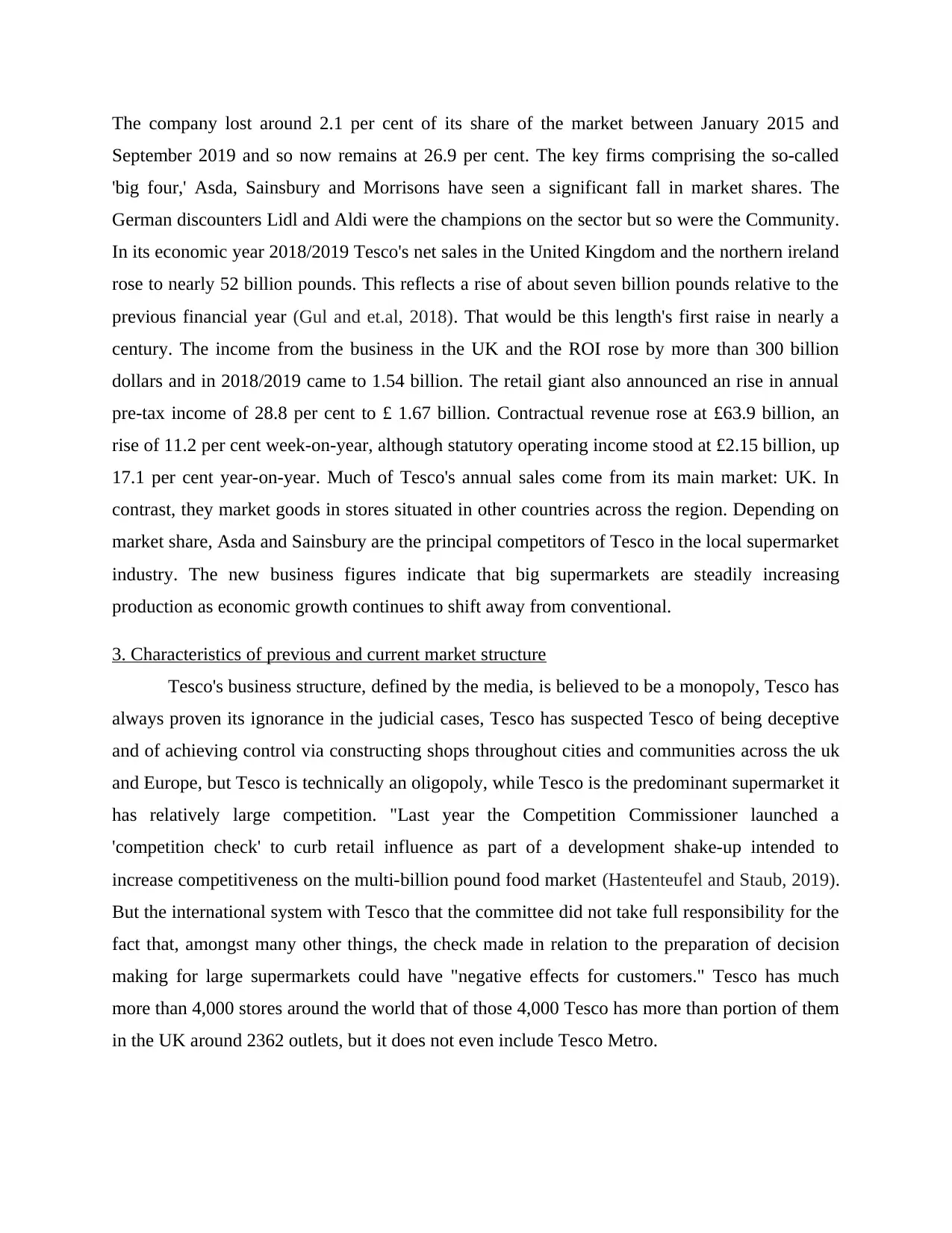
The company lost around 2.1 per cent of its share of the market between January 2015 and
September 2019 and so now remains at 26.9 per cent. The key firms comprising the so-called
'big four,' Asda, Sainsbury and Morrisons have seen a significant fall in market shares. The
German discounters Lidl and Aldi were the champions on the sector but so were the Community.
In its economic year 2018/2019 Tesco's net sales in the United Kingdom and the northern ireland
rose to nearly 52 billion pounds. This reflects a rise of about seven billion pounds relative to the
previous financial year (Gul and et.al, 2018). That would be this length's first raise in nearly a
century. The income from the business in the UK and the ROI rose by more than 300 billion
dollars and in 2018/2019 came to 1.54 billion. The retail giant also announced an rise in annual
pre-tax income of 28.8 per cent to £ 1.67 billion. Contractual revenue rose at £63.9 billion, an
rise of 11.2 per cent week-on-year, although statutory operating income stood at £2.15 billion, up
17.1 per cent year-on-year. Much of Tesco's annual sales come from its main market: UK. In
contrast, they market goods in stores situated in other countries across the region. Depending on
market share, Asda and Sainsbury are the principal competitors of Tesco in the local supermarket
industry. The new business figures indicate that big supermarkets are steadily increasing
production as economic growth continues to shift away from conventional.
3. Characteristics of previous and current market structure
Tesco's business structure, defined by the media, is believed to be a monopoly, Tesco has
always proven its ignorance in the judicial cases, Tesco has suspected Tesco of being deceptive
and of achieving control via constructing shops throughout cities and communities across the uk
and Europe, but Tesco is technically an oligopoly, while Tesco is the predominant supermarket it
has relatively large competition. "Last year the Competition Commissioner launched a
'competition check' to curb retail influence as part of a development shake-up intended to
increase competitiveness on the multi-billion pound food market (Hastenteufel and Staub, 2019).
But the international system with Tesco that the committee did not take full responsibility for the
fact that, amongst many other things, the check made in relation to the preparation of decision
making for large supermarkets could have "negative effects for customers." Tesco has much
more than 4,000 stores around the world that of those 4,000 Tesco has more than portion of them
in the UK around 2362 outlets, but it does not even include Tesco Metro.
September 2019 and so now remains at 26.9 per cent. The key firms comprising the so-called
'big four,' Asda, Sainsbury and Morrisons have seen a significant fall in market shares. The
German discounters Lidl and Aldi were the champions on the sector but so were the Community.
In its economic year 2018/2019 Tesco's net sales in the United Kingdom and the northern ireland
rose to nearly 52 billion pounds. This reflects a rise of about seven billion pounds relative to the
previous financial year (Gul and et.al, 2018). That would be this length's first raise in nearly a
century. The income from the business in the UK and the ROI rose by more than 300 billion
dollars and in 2018/2019 came to 1.54 billion. The retail giant also announced an rise in annual
pre-tax income of 28.8 per cent to £ 1.67 billion. Contractual revenue rose at £63.9 billion, an
rise of 11.2 per cent week-on-year, although statutory operating income stood at £2.15 billion, up
17.1 per cent year-on-year. Much of Tesco's annual sales come from its main market: UK. In
contrast, they market goods in stores situated in other countries across the region. Depending on
market share, Asda and Sainsbury are the principal competitors of Tesco in the local supermarket
industry. The new business figures indicate that big supermarkets are steadily increasing
production as economic growth continues to shift away from conventional.
3. Characteristics of previous and current market structure
Tesco's business structure, defined by the media, is believed to be a monopoly, Tesco has
always proven its ignorance in the judicial cases, Tesco has suspected Tesco of being deceptive
and of achieving control via constructing shops throughout cities and communities across the uk
and Europe, but Tesco is technically an oligopoly, while Tesco is the predominant supermarket it
has relatively large competition. "Last year the Competition Commissioner launched a
'competition check' to curb retail influence as part of a development shake-up intended to
increase competitiveness on the multi-billion pound food market (Hastenteufel and Staub, 2019).
But the international system with Tesco that the committee did not take full responsibility for the
fact that, amongst many other things, the check made in relation to the preparation of decision
making for large supermarkets could have "negative effects for customers." Tesco has much
more than 4,000 stores around the world that of those 4,000 Tesco has more than portion of them
in the UK around 2362 outlets, but it does not even include Tesco Metro.
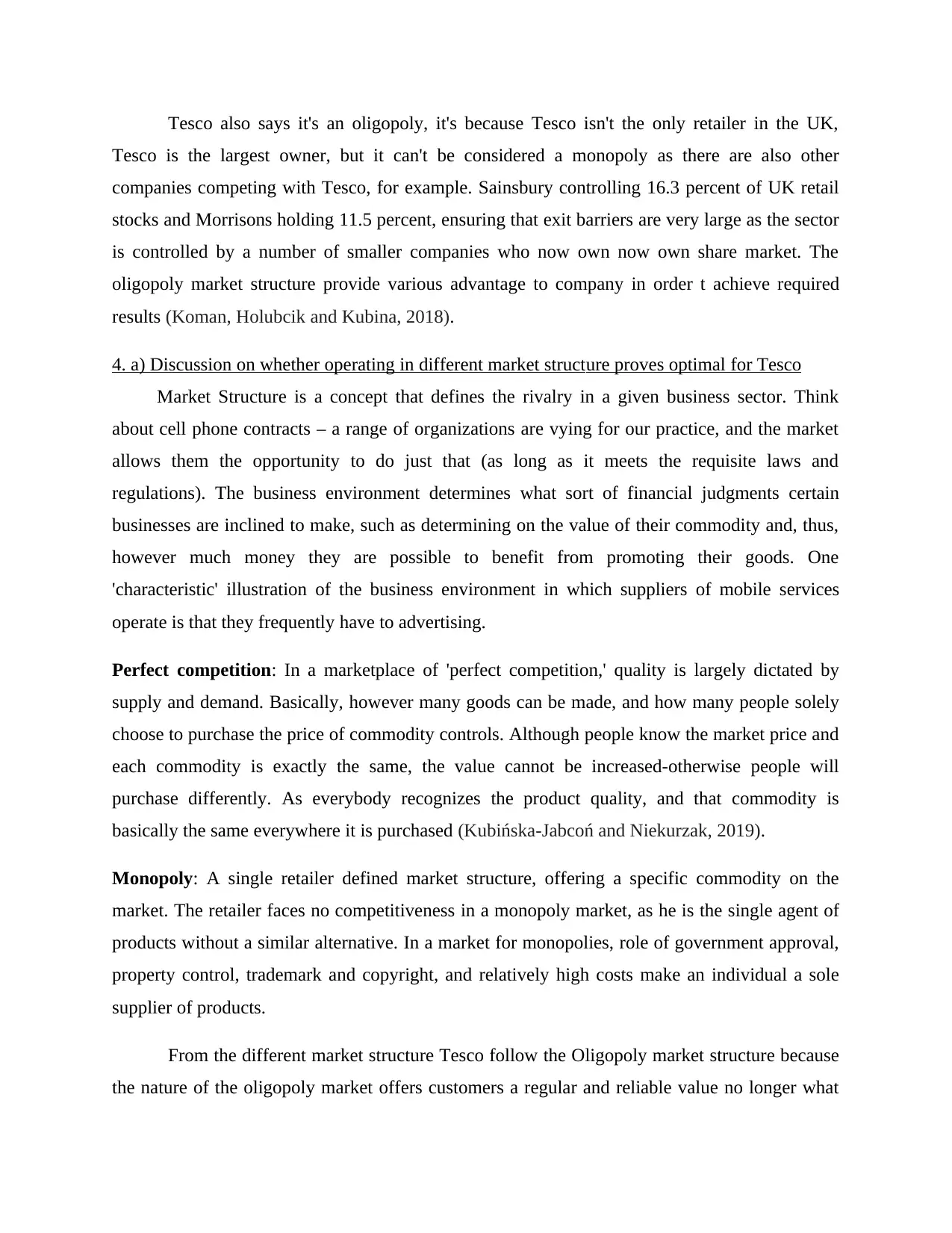
Tesco also says it's an oligopoly, it's because Tesco isn't the only retailer in the UK,
Tesco is the largest owner, but it can't be considered a monopoly as there are also other
companies competing with Tesco, for example. Sainsbury controlling 16.3 percent of UK retail
stocks and Morrisons holding 11.5 percent, ensuring that exit barriers are very large as the sector
is controlled by a number of smaller companies who now own now own share market. The
oligopoly market structure provide various advantage to company in order t achieve required
results (Koman, Holubcik and Kubina, 2018).
4. a) Discussion on whether operating in different market structure proves optimal for Tesco
Market Structure is a concept that defines the rivalry in a given business sector. Think
about cell phone contracts – a range of organizations are vying for our practice, and the market
allows them the opportunity to do just that (as long as it meets the requisite laws and
regulations). The business environment determines what sort of financial judgments certain
businesses are inclined to make, such as determining on the value of their commodity and, thus,
however much money they are possible to benefit from promoting their goods. One
'characteristic' illustration of the business environment in which suppliers of mobile services
operate is that they frequently have to advertising.
Perfect competition: In a marketplace of 'perfect competition,' quality is largely dictated by
supply and demand. Basically, however many goods can be made, and how many people solely
choose to purchase the price of commodity controls. Although people know the market price and
each commodity is exactly the same, the value cannot be increased-otherwise people will
purchase differently. As everybody recognizes the product quality, and that commodity is
basically the same everywhere it is purchased (Kubińska-Jabcoń and Niekurzak, 2019).
Monopoly: A single retailer defined market structure, offering a specific commodity on the
market. The retailer faces no competitiveness in a monopoly market, as he is the single agent of
products without a similar alternative. In a market for monopolies, role of government approval,
property control, trademark and copyright, and relatively high costs make an individual a sole
supplier of products.
From the different market structure Tesco follow the Oligopoly market structure because
the nature of the oligopoly market offers customers a regular and reliable value no longer what
Tesco is the largest owner, but it can't be considered a monopoly as there are also other
companies competing with Tesco, for example. Sainsbury controlling 16.3 percent of UK retail
stocks and Morrisons holding 11.5 percent, ensuring that exit barriers are very large as the sector
is controlled by a number of smaller companies who now own now own share market. The
oligopoly market structure provide various advantage to company in order t achieve required
results (Koman, Holubcik and Kubina, 2018).
4. a) Discussion on whether operating in different market structure proves optimal for Tesco
Market Structure is a concept that defines the rivalry in a given business sector. Think
about cell phone contracts – a range of organizations are vying for our practice, and the market
allows them the opportunity to do just that (as long as it meets the requisite laws and
regulations). The business environment determines what sort of financial judgments certain
businesses are inclined to make, such as determining on the value of their commodity and, thus,
however much money they are possible to benefit from promoting their goods. One
'characteristic' illustration of the business environment in which suppliers of mobile services
operate is that they frequently have to advertising.
Perfect competition: In a marketplace of 'perfect competition,' quality is largely dictated by
supply and demand. Basically, however many goods can be made, and how many people solely
choose to purchase the price of commodity controls. Although people know the market price and
each commodity is exactly the same, the value cannot be increased-otherwise people will
purchase differently. As everybody recognizes the product quality, and that commodity is
basically the same everywhere it is purchased (Kubińska-Jabcoń and Niekurzak, 2019).
Monopoly: A single retailer defined market structure, offering a specific commodity on the
market. The retailer faces no competitiveness in a monopoly market, as he is the single agent of
products without a similar alternative. In a market for monopolies, role of government approval,
property control, trademark and copyright, and relatively high costs make an individual a sole
supplier of products.
From the different market structure Tesco follow the Oligopoly market structure because
the nature of the oligopoly market offers customers a regular and reliable value no longer what
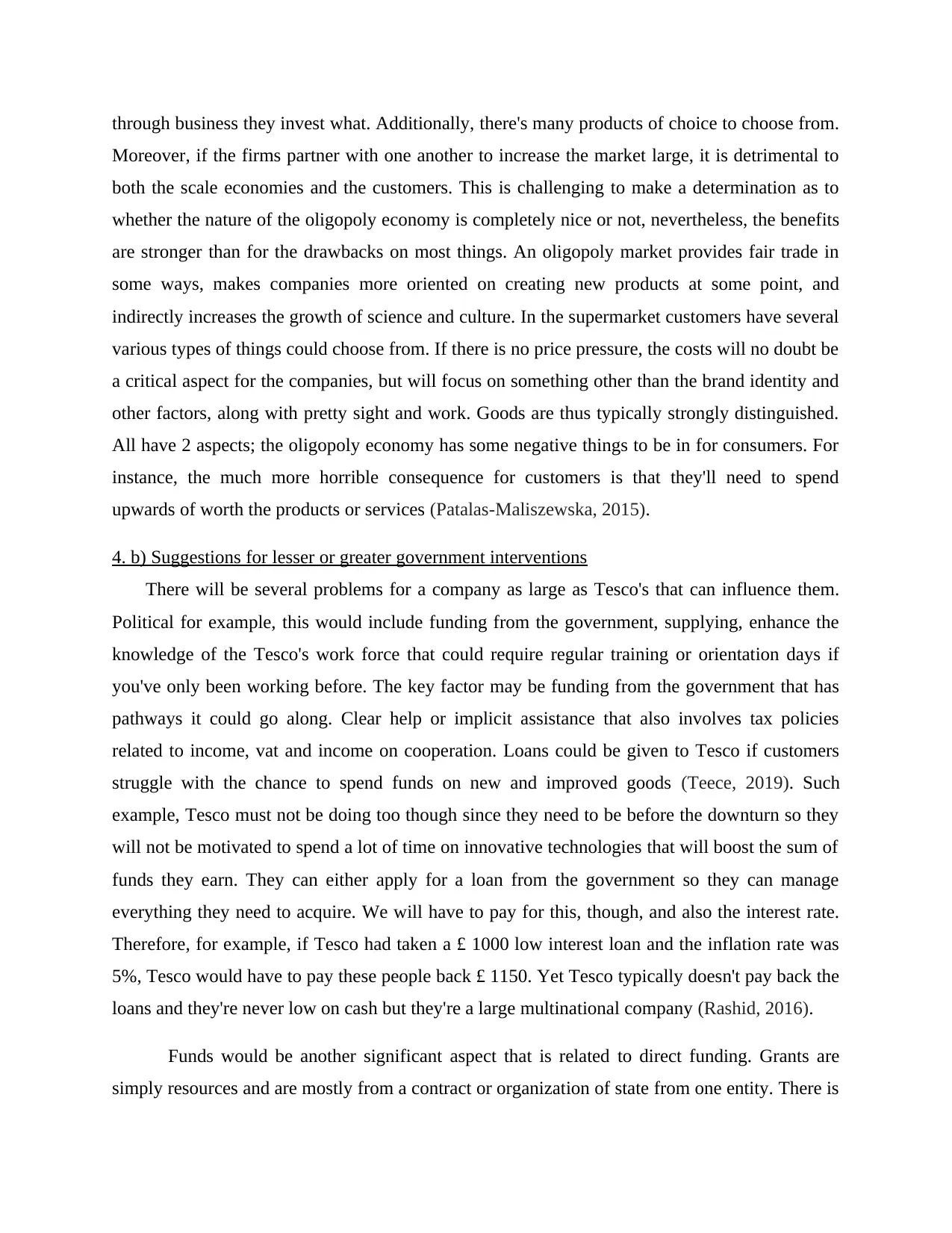
through business they invest what. Additionally, there's many products of choice to choose from.
Moreover, if the firms partner with one another to increase the market large, it is detrimental to
both the scale economies and the customers. This is challenging to make a determination as to
whether the nature of the oligopoly economy is completely nice or not, nevertheless, the benefits
are stronger than for the drawbacks on most things. An oligopoly market provides fair trade in
some ways, makes companies more oriented on creating new products at some point, and
indirectly increases the growth of science and culture. In the supermarket customers have several
various types of things could choose from. If there is no price pressure, the costs will no doubt be
a critical aspect for the companies, but will focus on something other than the brand identity and
other factors, along with pretty sight and work. Goods are thus typically strongly distinguished.
All have 2 aspects; the oligopoly economy has some negative things to be in for consumers. For
instance, the much more horrible consequence for customers is that they'll need to spend
upwards of worth the products or services (Patalas-Maliszewska, 2015).
4. b) Suggestions for lesser or greater government interventions
There will be several problems for a company as large as Tesco's that can influence them.
Political for example, this would include funding from the government, supplying, enhance the
knowledge of the Tesco's work force that could require regular training or orientation days if
you've only been working before. The key factor may be funding from the government that has
pathways it could go along. Clear help or implicit assistance that also involves tax policies
related to income, vat and income on cooperation. Loans could be given to Tesco if customers
struggle with the chance to spend funds on new and improved goods (Teece, 2019). Such
example, Tesco must not be doing too though since they need to be before the downturn so they
will not be motivated to spend a lot of time on innovative technologies that will boost the sum of
funds they earn. They can either apply for a loan from the government so they can manage
everything they need to acquire. We will have to pay for this, though, and also the interest rate.
Therefore, for example, if Tesco had taken a £ 1000 low interest loan and the inflation rate was
5%, Tesco would have to pay these people back £ 1150. Yet Tesco typically doesn't pay back the
loans and they're never low on cash but they're a large multinational company (Rashid, 2016).
Funds would be another significant aspect that is related to direct funding. Grants are
simply resources and are mostly from a contract or organization of state from one entity. There is
Moreover, if the firms partner with one another to increase the market large, it is detrimental to
both the scale economies and the customers. This is challenging to make a determination as to
whether the nature of the oligopoly economy is completely nice or not, nevertheless, the benefits
are stronger than for the drawbacks on most things. An oligopoly market provides fair trade in
some ways, makes companies more oriented on creating new products at some point, and
indirectly increases the growth of science and culture. In the supermarket customers have several
various types of things could choose from. If there is no price pressure, the costs will no doubt be
a critical aspect for the companies, but will focus on something other than the brand identity and
other factors, along with pretty sight and work. Goods are thus typically strongly distinguished.
All have 2 aspects; the oligopoly economy has some negative things to be in for consumers. For
instance, the much more horrible consequence for customers is that they'll need to spend
upwards of worth the products or services (Patalas-Maliszewska, 2015).
4. b) Suggestions for lesser or greater government interventions
There will be several problems for a company as large as Tesco's that can influence them.
Political for example, this would include funding from the government, supplying, enhance the
knowledge of the Tesco's work force that could require regular training or orientation days if
you've only been working before. The key factor may be funding from the government that has
pathways it could go along. Clear help or implicit assistance that also involves tax policies
related to income, vat and income on cooperation. Loans could be given to Tesco if customers
struggle with the chance to spend funds on new and improved goods (Teece, 2019). Such
example, Tesco must not be doing too though since they need to be before the downturn so they
will not be motivated to spend a lot of time on innovative technologies that will boost the sum of
funds they earn. They can either apply for a loan from the government so they can manage
everything they need to acquire. We will have to pay for this, though, and also the interest rate.
Therefore, for example, if Tesco had taken a £ 1000 low interest loan and the inflation rate was
5%, Tesco would have to pay these people back £ 1150. Yet Tesco typically doesn't pay back the
loans and they're never low on cash but they're a large multinational company (Rashid, 2016).
Funds would be another significant aspect that is related to direct funding. Grants are
simply resources and are mostly from a contract or organization of state from one entity. There is
Secure Best Marks with AI Grader
Need help grading? Try our AI Grader for instant feedback on your assignments.
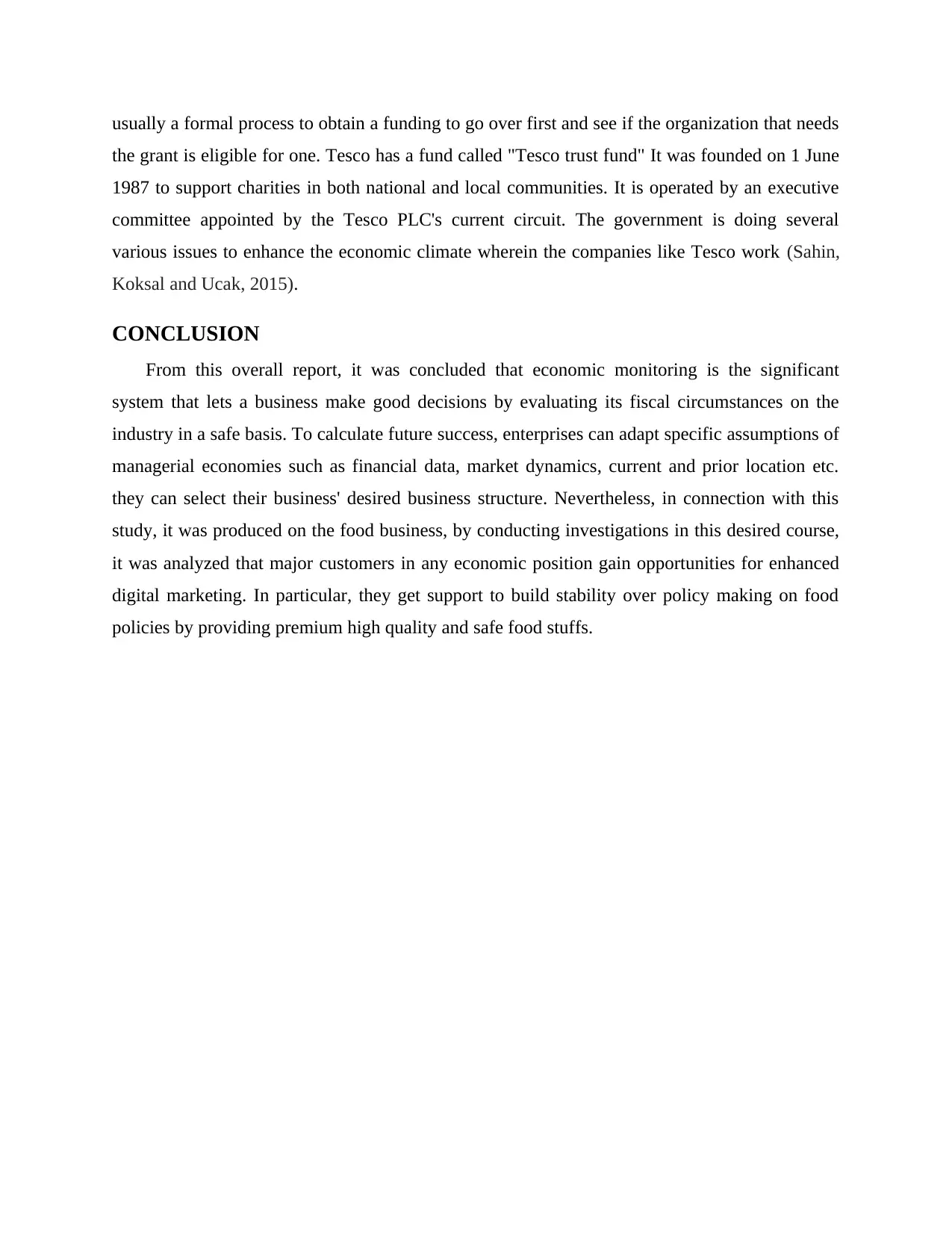
usually a formal process to obtain a funding to go over first and see if the organization that needs
the grant is eligible for one. Tesco has a fund called "Tesco trust fund" It was founded on 1 June
1987 to support charities in both national and local communities. It is operated by an executive
committee appointed by the Tesco PLC's current circuit. The government is doing several
various issues to enhance the economic climate wherein the companies like Tesco work (Sahin,
Koksal and Ucak, 2015).
CONCLUSION
From this overall report, it was concluded that economic monitoring is the significant
system that lets a business make good decisions by evaluating its fiscal circumstances on the
industry in a safe basis. To calculate future success, enterprises can adapt specific assumptions of
managerial economies such as financial data, market dynamics, current and prior location etc.
they can select their business' desired business structure. Nevertheless, in connection with this
study, it was produced on the food business, by conducting investigations in this desired course,
it was analyzed that major customers in any economic position gain opportunities for enhanced
digital marketing. In particular, they get support to build stability over policy making on food
policies by providing premium high quality and safe food stuffs.
the grant is eligible for one. Tesco has a fund called "Tesco trust fund" It was founded on 1 June
1987 to support charities in both national and local communities. It is operated by an executive
committee appointed by the Tesco PLC's current circuit. The government is doing several
various issues to enhance the economic climate wherein the companies like Tesco work (Sahin,
Koksal and Ucak, 2015).
CONCLUSION
From this overall report, it was concluded that economic monitoring is the significant
system that lets a business make good decisions by evaluating its fiscal circumstances on the
industry in a safe basis. To calculate future success, enterprises can adapt specific assumptions of
managerial economies such as financial data, market dynamics, current and prior location etc.
they can select their business' desired business structure. Nevertheless, in connection with this
study, it was produced on the food business, by conducting investigations in this desired course,
it was analyzed that major customers in any economic position gain opportunities for enhanced
digital marketing. In particular, they get support to build stability over policy making on food
policies by providing premium high quality and safe food stuffs.
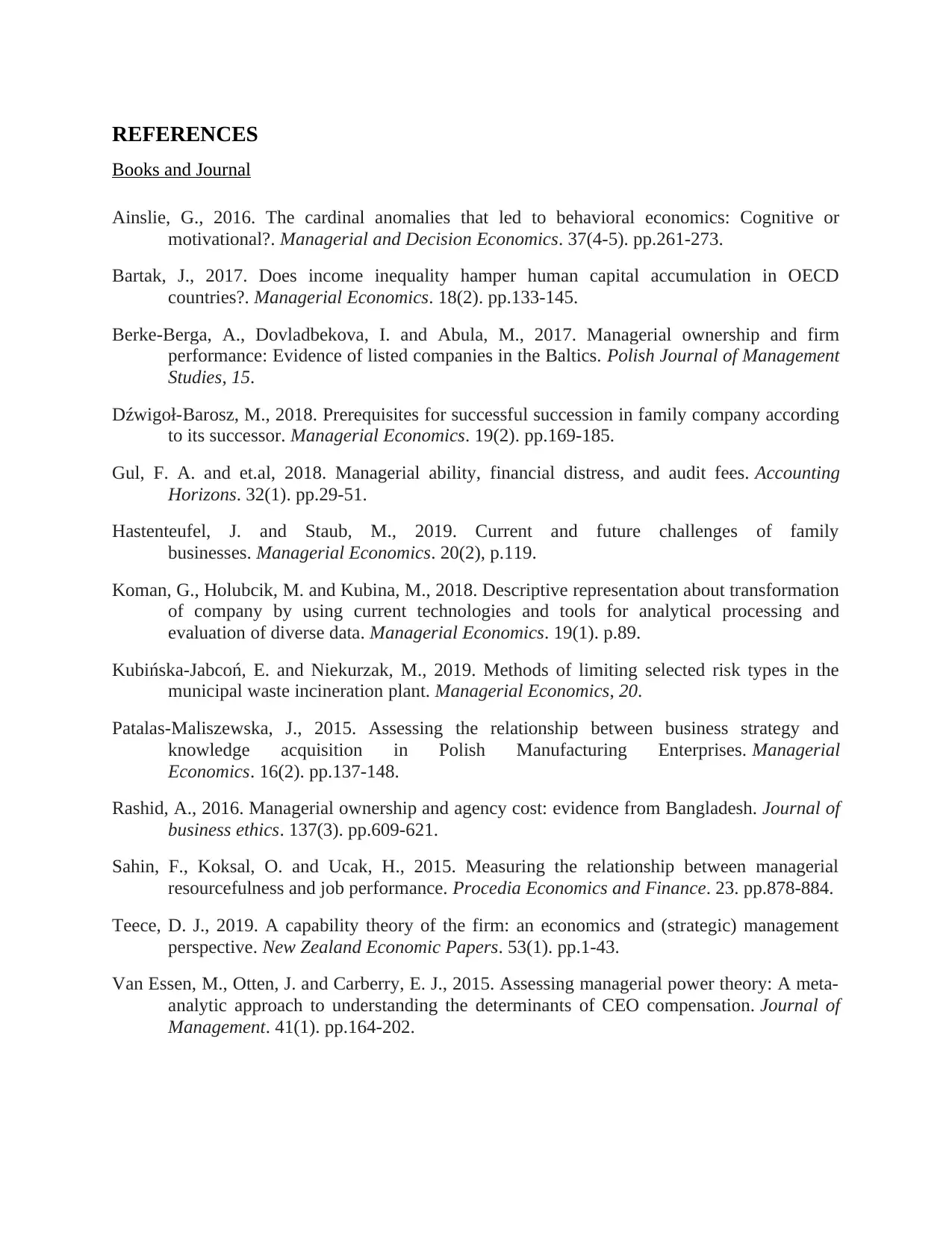
REFERENCES
Books and Journal
Ainslie, G., 2016. The cardinal anomalies that led to behavioral economics: Cognitive or
motivational?. Managerial and Decision Economics. 37(4-5). pp.261-273.
Bartak, J., 2017. Does income inequality hamper human capital accumulation in OECD
countries?. Managerial Economics. 18(2). pp.133-145.
Berke-Berga, A., Dovladbekova, I. and Abula, M., 2017. Managerial ownership and firm
performance: Evidence of listed companies in the Baltics. Polish Journal of Management
Studies, 15.
Dźwigoł-Barosz, M., 2018. Prerequisites for successful succession in family company according
to its successor. Managerial Economics. 19(2). pp.169-185.
Gul, F. A. and et.al, 2018. Managerial ability, financial distress, and audit fees. Accounting
Horizons. 32(1). pp.29-51.
Hastenteufel, J. and Staub, M., 2019. Current and future challenges of family
businesses. Managerial Economics. 20(2), p.119.
Koman, G., Holubcik, M. and Kubina, M., 2018. Descriptive representation about transformation
of company by using current technologies and tools for analytical processing and
evaluation of diverse data. Managerial Economics. 19(1). p.89.
Kubińska-Jabcoń, E. and Niekurzak, M., 2019. Methods of limiting selected risk types in the
municipal waste incineration plant. Managerial Economics, 20.
Patalas-Maliszewska, J., 2015. Assessing the relationship between business strategy and
knowledge acquisition in Polish Manufacturing Enterprises. Managerial
Economics. 16(2). pp.137-148.
Rashid, A., 2016. Managerial ownership and agency cost: evidence from Bangladesh. Journal of
business ethics. 137(3). pp.609-621.
Sahin, F., Koksal, O. and Ucak, H., 2015. Measuring the relationship between managerial
resourcefulness and job performance. Procedia Economics and Finance. 23. pp.878-884.
Teece, D. J., 2019. A capability theory of the firm: an economics and (strategic) management
perspective. New Zealand Economic Papers. 53(1). pp.1-43.
Van Essen, M., Otten, J. and Carberry, E. J., 2015. Assessing managerial power theory: A meta-
analytic approach to understanding the determinants of CEO compensation. Journal of
Management. 41(1). pp.164-202.
Books and Journal
Ainslie, G., 2016. The cardinal anomalies that led to behavioral economics: Cognitive or
motivational?. Managerial and Decision Economics. 37(4-5). pp.261-273.
Bartak, J., 2017. Does income inequality hamper human capital accumulation in OECD
countries?. Managerial Economics. 18(2). pp.133-145.
Berke-Berga, A., Dovladbekova, I. and Abula, M., 2017. Managerial ownership and firm
performance: Evidence of listed companies in the Baltics. Polish Journal of Management
Studies, 15.
Dźwigoł-Barosz, M., 2018. Prerequisites for successful succession in family company according
to its successor. Managerial Economics. 19(2). pp.169-185.
Gul, F. A. and et.al, 2018. Managerial ability, financial distress, and audit fees. Accounting
Horizons. 32(1). pp.29-51.
Hastenteufel, J. and Staub, M., 2019. Current and future challenges of family
businesses. Managerial Economics. 20(2), p.119.
Koman, G., Holubcik, M. and Kubina, M., 2018. Descriptive representation about transformation
of company by using current technologies and tools for analytical processing and
evaluation of diverse data. Managerial Economics. 19(1). p.89.
Kubińska-Jabcoń, E. and Niekurzak, M., 2019. Methods of limiting selected risk types in the
municipal waste incineration plant. Managerial Economics, 20.
Patalas-Maliszewska, J., 2015. Assessing the relationship between business strategy and
knowledge acquisition in Polish Manufacturing Enterprises. Managerial
Economics. 16(2). pp.137-148.
Rashid, A., 2016. Managerial ownership and agency cost: evidence from Bangladesh. Journal of
business ethics. 137(3). pp.609-621.
Sahin, F., Koksal, O. and Ucak, H., 2015. Measuring the relationship between managerial
resourcefulness and job performance. Procedia Economics and Finance. 23. pp.878-884.
Teece, D. J., 2019. A capability theory of the firm: an economics and (strategic) management
perspective. New Zealand Economic Papers. 53(1). pp.1-43.
Van Essen, M., Otten, J. and Carberry, E. J., 2015. Assessing managerial power theory: A meta-
analytic approach to understanding the determinants of CEO compensation. Journal of
Management. 41(1). pp.164-202.

1 out of 13
Related Documents
Your All-in-One AI-Powered Toolkit for Academic Success.
+13062052269
info@desklib.com
Available 24*7 on WhatsApp / Email
![[object Object]](/_next/static/media/star-bottom.7253800d.svg)
Unlock your academic potential
© 2024 | Zucol Services PVT LTD | All rights reserved.





